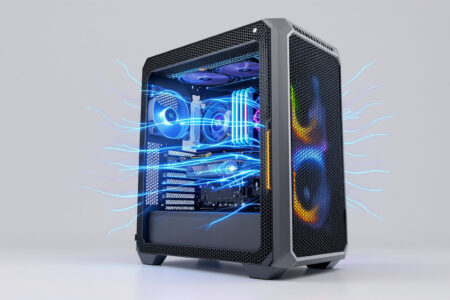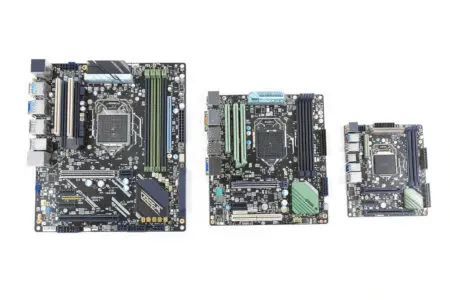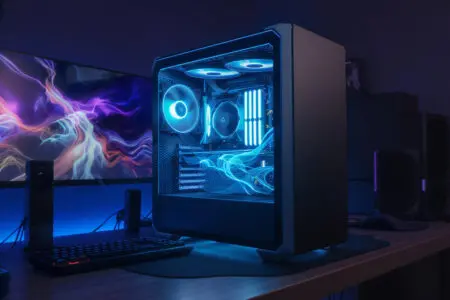Ever wondered why the frame rates in your favorite game look so much smoother on a streamer’s channel than on your own machine? It’s not magic; it’s custom-built power. If you’ve ever considered diving into the world of custom PCs, you’ve come to the right place. Learning how to build a gaming PC is more than just a technical project; it’s a rite of passage that gives you ultimate control over your gaming destiny, often while saving you a surprising amount of money.
This isn’t just about assembling parts. It’s about crafting a machine perfectly tailored to your needs, whether you’re aiming for buttery-smooth 1440p gameplay, a 4K powerhouse, or a budget-friendly rig that still crushes the latest titles. Let’s get started.
More in Hardware Category
Why Should You Build Your Own Gaming PC Instead of Buying One?
In a world filled with pre-built options from major brands, the idea of building your own computer can seem intimidating. However, the benefits are substantial and go far beyond just saving a few bucks. You’re not just buying a product; you’re investing in a personalized experience.
The biggest advantage is undoubtedly customization. When you buy a pre-built PC, you’re often stuck with a configuration that has a weak link. A company might pair a high-end graphics card with a slow SSD, a bare-bones motherboard, or an inadequate power supply to cut costs. When you build it yourself, you choose every single component. Consequently, you control the quality, performance, and aesthetics of your entire setup.
Moreover, there’s the thrill of the build itself. I remember the first time I built my own PC. My hands were practically shaking as I seated the CPU, terrified I was going to bend a pin. But when I pressed the power button and it whirred to life, the sense of accomplishment was immense. It’s a rewarding, educational experience that connects you to the technology you use every day.
Is It Really Cheaper to Build a PC in 2025?
The cost-effectiveness of building versus buying often fluctuates with the market. While there are times when pre-built systems on sale can be competitive, you almost always get a better performance-to-dollar ratio by building your own. You avoid the labor costs and profit margins that manufacturers add. More importantly, you can strategically allocate your budget to the components that matter most for gaming, like the graphics card, instead of paying for bundled software or features you don’t need.
What Are the Essential Components for a Gaming PC Build?
Before you can start building, you need to go shopping. This list covers the core components that form the foundation of any gaming PC. Think of these as your essential, non-negotiable parts.
- Processor (CPU): The brain of the operation.
- Motherboard: The central hub connecting everything.
- Memory (RAM): Your PC’s short-term memory for active tasks.
- Storage (SSD/HDD): The long-term storage for your OS, games, and files.
- Graphics Card (GPU): The most crucial part for gaming performance.
- Power Supply Unit (PSU): The heart that pumps power to everything.
- Case: The skeleton that holds it all together.
How Do I Choose the Right CPU for Gaming?
Your CPU, or Central Processing Unit, handles all the instructions that your computer needs to operate. In gaming, it’s responsible for things like AI, physics, and managing game logic. For years, the choice has been between two main players: Intel and AMD. Both offer fantastic options at every price point.
When choosing, look at a few key metrics: clock speed (measured in GHz) and core/thread count. While more cores are great for multitasking and productivity, many games still rely heavily on strong single-core performance. A CPU with a high clock speed will often provide a snappier gaming experience. For a purely gaming-focused build, you don’t need the most expensive 16-core monster. A solid 6 or 8-core processor from the latest generation is typically the sweet spot for performance and value.
What Should I Look for in a Motherboard?
If the CPU is the brain, the motherboard is the nervous system. Its primary job is to connect all your components so they can communicate. The most critical factor when choosing a motherboard is ensuring it’s compatible with your CPU. For example, AMD and Intel use different “sockets,” so a motherboard designed for one will not work with the other.
You also need to consider the form factor, which determines the physical size of the board. The most common sizes are:
- ATX: The standard, full-sized board with the most expansion slots.
- Micro-ATX: A smaller, more compact version that fits in smaller cases.
- Mini-ITX: A tiny form factor for very small, specialized builds.
For most builders, an ATX or Micro-ATX board offers the best balance of features and size. Make sure it has enough RAM slots (four is standard), M.2 slots for fast SSDs, and the connectivity you need.
How Much RAM is Enough for Modern Gaming?
RAM, or Random Access Memory, is where your PC temporarily stores data for applications that are currently running. Having enough RAM is crucial for smooth multitasking and preventing stutters in games. My first build had 8GB, which felt like a massive amount at the time. Today, that’s considered the bare minimum.
For a modern gaming PC, 16GB of RAM is the sweet spot. It provides plenty of headroom for the latest titles, along with background applications like Discord or a web browser. If you’re into heavy multitasking, streaming, or want to future-proof your build, jumping to 32GB is a worthwhile investment. Also, pay attention to RAM speed (measured in MHz); faster RAM can provide a noticeable performance boost, especially with AMD CPUs.
What’s the Best Storage Option: SSD or HDD?
The difference between a Solid State Drive (SSD) and a Hard Disk Drive (HDD) is night and day. HDDs are mechanical drives with spinning platters, while SSDs use flash memory, making them significantly faster.
For any gaming PC, an NVMe M.2 SSD is an absolute must-have for your operating system and favorite games. The dramatically reduced loading times will change your life. A PC booting up in seconds and games loading new levels almost instantly is a game-changer. Since larger SSDs can be pricey, a popular strategy is to use a smaller, faster SSD (like 1TB) as your primary drive and supplement it with a larger, cheaper HDD (2TB or more) for storing media files, documents, and less-played games.
How Do I Pick the Most Powerful Graphics Card I Can Afford?
Welcome to the main event. The Graphics Processing Unit (GPU) is the single most important component for gaming. It’s responsible for rendering all the beautiful images you see on screen. Your choice of GPU will have a bigger impact on your frame rates than any other part.
The two main manufacturers are NVIDIA (with their GeForce line) and AMD (with their Radeon line). Your decision here should be based on your budget and your performance target. Are you aiming for 1080p at a high refresh rate, a crisp 1440p experience, or the demanding heights of 4K? The more pixels you want to push, the more powerful your GPU needs to be. Pay attention to the amount of VRAM (video memory) on the card; more VRAM helps with high-resolution textures and future games.
How Do I Calculate the Right Wattage for My Power Supply?
The Power Supply Unit (PSU) is often overlooked, but it’s a critical component for system stability and safety. I learned this the hard way once when I tried to save money on a cheap, unrated PSU. It failed spectacularly, and I was lucky it didn’t damage other components.
A good PSU delivers clean, stable power. Look for units with an “80 Plus” efficiency rating (Bronze, Gold, Platinum, etc.), which indicates how efficiently it converts power from the wall. To determine how much wattage you need, you can use an online PSU calculator. Simply enter all your components, and it will estimate your power draw. A good rule of thumb is to choose a PSU that provides about 100-150 watts more than your estimated peak consumption. This gives you headroom for future upgrades and ensures the PSU isn’t running at its absolute limit.
What Should I Consider When Choosing a PC Case?
The case does more than just house your components; it’s crucial for cooling and aesthetics. The most important factor to consider is airflow. A case with a mesh front panel and multiple fan mounts will do a much better job of keeping your components cool than a sealed-off box. Good airflow directly translates to better, more consistent performance.
You also need to ensure the case is compatible with your motherboard’s form factor (ATX, Micro-ATX, etc.) and is large enough to fit your graphics card, which can be surprisingly long. Finally, look for quality-of-life features like good cable management channels and dust filters. These make the building process much cleaner and easier.
How Do I Actually Assemble My Gaming PC?
This is where the fun begins. Assembling a PC is often compared to building with LEGOs, but with more expensive, fragile pieces. Take your time, stay organized, and read your motherboard manual. It’s your single most important tool.
Before you start, prepare your workspace. You’ll want a large, clean, well-lit area and a Phillips head screwdriver. Using an anti-static wrist strap is also a good precaution to protect your components from static discharge.
Step 1: Preparing the Motherboard
It’s easiest to install the CPU, RAM, and M.2 SSD onto the motherboard before you put it in the case.
- Install the CPU: Open the retention arm on the CPU socket. Look for the small triangle on both the CPU and the socket, align them, and gently place the processor in. It should drop in without any force. Then, lower the retention arm to lock it in place.
- Install the RAM: Open the clips on the RAM slots. Align the notch on the bottom of the RAM stick with the notch in the slot and press down firmly on both ends until the clips click into place.
- Install the M.2 SSD: Locate the M.2 slot on your motherboard, unscrew the small standoff, insert the drive at an angle, and then press it down and secure it with the screw.
Step 2: Mounting the Motherboard in the Case
First, install the motherboard’s I/O shield (the thin metal plate for your ports) into the back of the case. Next, screw the motherboard standoffs into the case, making sure they align with the holes on your motherboard. Carefully lower the motherboard onto the standoffs and secure it with screws.
Step 3: Installing the Graphics Card and Other Components
Now it’s time for the big parts.
- Graphics Card: Remove the PCIe slot covers on the back of the case that align with the top PCIe x16 slot on your motherboard. Open the retention clip on the slot, align the card, and press it in firmly until it clicks. Secure it to the case with screws.
- Power Supply: The PSU is usually installed at the bottom or top rear of the case. Screw it in securely.
- Storage Drives: If you have any 2.5″ or 3.5″ drives, mount them in the drive bays provided in your case.
Step 4: Connecting All the Wires (Cable Management)
This can be the most tedious part of the build, especially the tiny front panel connectors.
- Main Power: Connect the large 24-pin connector from the PSU to the motherboard.
- CPU Power: Connect the 4+4 pin CPU power connector, usually located near the top of the motherboard.
- GPU Power: Most gaming GPUs require additional power via 6-pin or 8-pin PCIe power connectors from the PSU.
- SATA Power & Data: Connect power from the PSU and data cables from the motherboard to any SATA drives.
- Front Panel Connectors: This is where you connect the case’s power button, reset button, USB ports, and audio jacks to the motherboard. These are tiny, individual pins. Consult your motherboard manual to see exactly where each one goes. I always use my phone’s flashlight for this step.
Step 5: The Moment of Truth – First Boot
Double-check all your connections. Plug in your power cord, monitor, keyboard, and mouse. Take a deep breath and press the power button. If all goes well, the fans will spin, lights will turn on, and you’ll see a message on your screen prompting you to enter the BIOS or UEFI. Congratulations, you’ve successfully assembled a PC!
What Do I Do After My PC Turns On for the First Time?
Your hardware is assembled, but the job isn’t done. Now you need to install the software that brings your machine to life.
How Do I Install an Operating System?
You’ll need another computer to create a bootable USB drive with your chosen operating system (most commonly Windows). Once you have your bootable USB, plug it into your new PC, turn it on, and enter the BIOS/UEFI (usually by pressing the ‘Delete’ or ‘F2’ key on startup). From there, find the boot menu and set the USB drive as your primary boot device. Save and exit, and your PC will reboot and begin the OS installation process.
What Are the Essential Drivers I Need to Install?
Drivers are the software that allows your operating system to communicate with your hardware. This is a critical step. Forgetting to install your GPU drivers is a classic mistake that leaves you with sluggish performance.
- Graphics Card Drivers: Go directly to the NVIDIA or AMD website and download the latest drivers for your specific GPU model. This is the most important one for gaming.
- Motherboard Chipset Drivers: Go to your motherboard manufacturer’s website and download the latest chipset drivers. This ensures all the integrated components work correctly.
- Other Drivers: You’ll also find drivers for your LAN/Wi-Fi and audio on the motherboard’s support page.
What Other Software Should I Get?
With your system up and running, it’s time to install the good stuff. Get your preferred game launchers like Steam or the Epic Games Store, communication software like Discord, and any other programs you use daily. It’s also a good idea to install a hardware monitoring utility to keep an eye on your component temperatures and performance.
Are You Ready to Start Your PC Building Journey?
Building a gaming PC is an incredibly empowering experience. It might seem daunting at first, but it’s a logical process that millions of people have successfully navigated. You’ve now learned about the components you’ll need, the steps to assemble them, and the software to install afterward.
The result is a machine that is uniquely yours, tailored to your exact specifications, and often more powerful than anything you could have bought off the shelf for the same price. You gain a deep understanding of the technology you use and the satisfaction of knowing you built it with your own two hands. So go ahead, start planning your build, and prepare to take your gaming to a whole new level. For those who want to dive deep into the technical specifications and research papers behind the components that power these machines, university resources like the Computer Science collection at Stanford Libraries can be an excellent place to start.
Frequently Asked Questions

Why is the power supply unit (PSU) important, and what should I consider when choosing one?
The PSU supplies power to your PC components, so it must provide enough wattage with some extra capacity, usually between 750W and 850W for most builds. Look for an efficient (80 Plus Bronze or Gold) modular PSU to ensure safety, energy efficiency, and easier cable management.
How do I select a compatible motherboard for my gaming PC build?
Choose a motherboard with a socket type that matches your CPU, like LGA 1700 for Intel or AM5 for AMD. Also, consider the form factor, RAM slots, and connectivity options such as USB ports, M.2 slots, and Wi-Fi support to fit your needs.
What are the key features to look for in a graphics card for gaming?
Look for a GPU with sufficient VRAM—8GB for 1080p, and 12GB or more for 1440p or 4K gaming—and check benchmarks and reviews for the games you want to play, ensuring it meets your performance needs.
How should I choose the right CPU for my gaming PC?
Select a CPU with at least 6 cores and a high clock speed, considering brands like Intel’s Core series or AMD’s Ryzen series. Matching the CPU to the motherboard socket, such as LGA 1700 for Intel or AM5 for AMD, is crucial for compatibility.
What are the main benefits of learning how to build a gaming PC?
Learning allows you to select all components personally, ensuring the system is tailored to your needs. It offers better value for money by focusing on the parts you need, and it provides valuable experience and knowledge for future upgrades and repairs.





